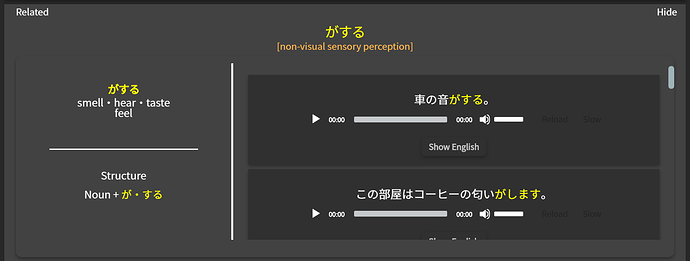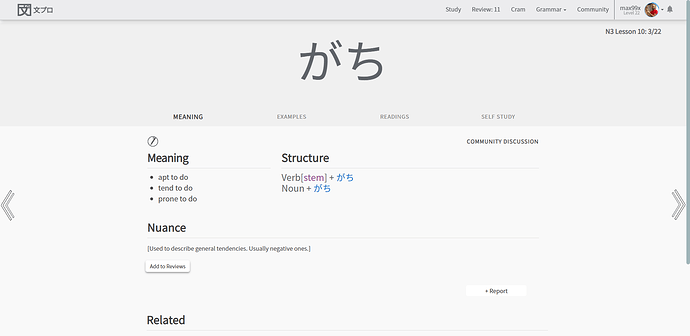Shouldn’t
https://www.bunpro.jp/grammar_points/16
and
https://www.bunpro.jp/grammar_points/719
be marked as related? They are the same construct applied to verbs and adjectives respectively after all, aren’t they?
It’s weird that when I go to the home page while logged in I get the sales page. I’d expect to get my personal status page, like on WK.
I’ve noticed this too and also this it is strange.
I used Bunpro before WK so I was used to the sales page but it would make more sense to go to the profile page when logged in.
-
These are the related grammar points for にみえる. What’s up with がする being red? Is that explained somewhere on the site? I remember seeing an FAQ on these forums, but I don’t remember where it was
-
I think it’d be a good idea to link to the FAQ in the dropdown menu from the user’s profile picture

-
(Edit:) I found that the FAQ is linked in the dropdown menu from the “community” page here, but it is still sorely missing from the main 文プロ profile page!!
-
Also, the dropdown menu still has a redundant Community link that for some reason has a different destination than the Community link in the header
This is what appears if you click on がする above:
-
Can we get a hyperlink to the grammar’s own grammar point, maybe in the header where it reads がする here?
-
Also, if the grammar in question has mouseover kanji, maybe this would be a cool place to incorporate it as well

-
Is there a way (hyperlink) to return to the user’s main 文プロ profile page from the community page?
-
Either way, I think it might be a good idea to make the “Community” link on the profile page open a new tab (instead of following the link using the active tab)
(Sorry this post was so disorganized; hopefully the numbering helps at least a little)
@Kai Thank you for your comment.
-
Grammar points that appear in red either have opposite meanings to the main grammar point or they require special attention. Since にみえる is based on visual cues and がする is used to describe non-visual sensory perception, we wanted to highlight that these two grammar points could not be interchanged. It might be better to add a third category to related (something like similar, opposite (antonym) and caution).
-
Linking the FAQ in the dropdown menu could be an option.
-
We currently have the FAQ listed at the bottom of main pages (grammar page, profile page, etc.).
-
Thank you for reminding us! We will get that updated.
-
If you click on the related grammar tile a second time, it will open the main page for that grammar point.
-
Good idea! We will see what we can do.
-
We will update the “Home” button to redirect to the profile page, rather than the Bunpro landing page.
-
We will update the “Community” link to open in a new tab. Cheers!
That is not very intuitive, especially since that tile/button is suddenly pushed down further (meaning you have to scroll down to see it). I liked @Kai suggestion of clicking on the header for the grammar point, that is in fact where I have tried clicking in the past to open the full grammar point. 
As a side note it might actually make since to have the tiles/buttons above the related grammar info when it is open. It is always nicer UI when things doesn’t jump around. Now the tiles are pushed below the new info, meaning they seemingly disappear because they aren’t visible anymore without scrolling. (This might not be true for all browsers/screen sizes, but it is for me.)
I’ve been following the Genki path and saw that the “frequency adverbs” was missing (Page 93)
Which is fine, saw that the focus was adding textbook grammar that wasn’t on here yet
BUT, I did search and saw that you do have ぜんぜん and is linked to I think みんなの日本語
so I think that could be a quick add!
And just for refence, the other stuff I mentioned but I think aren’t added yet are
まいにち、よく、ときどき、あまり
Sorry if this wasn’t really the best way to put this in, think it fits though
Hey and welcome on the community forums!
I have added those to the to-do list, and informed person responsible for the paths feature about ぜんぜん, thank you!
Cheers!
@MissDagger Thank you for your insight! We decided to have the related grammar tabs move below the grammar info so that you could more easily compare two grammar structures, notes and sentences side by side. That being said, we will see what we can do about making the related grammar section more intuitive. We agree that it could use a little facelift and some extra functionality. Cheers!
@thanatosskepsi Welcome to the community and thank you for your comment. I have added 全然 and あまり〜ない to the Genki I Path. Once we have more grammar to add, we will do so. Cheers!
I think the heatmap in the stats section can be improved. The way it works now, you always have to scroll just to see recent data since it always starts from April 2018.
I think reverse order would be perfect, just flip it around 
Not sure where to post this but I don’t inderstand this:
おいでになる 時間(じかん)をお伝(つた)えください。[くる]
Please let me know what time you will arrive (come) .
How come くる becomes いで ?
Jisho says it’s a set expression: https://jisho.org/search/おいでになる
PS If you use Chrome or FF, you can get the extension Rikaikun/Rikaichan to help you with things like this. Hovering over it tells you the entire thing is a verb that’s honorific.
I like that look! The default BunPro style has always bothered me a bit. I hacked together a Stylish script to kinda reproduce it to the extent that’s reasonable without messing with the content. Only applies if you have the (light) Modern theme selected, and I only tested on Desktop Chrome with a widish window size. Try it at: https://userstyles.org/styles/176895/bunpro-wk-style-wip
That is the honorific form of 来る。
@max99x
Whoa, looks so clean!
@0_0
Like @Sidgr said, お出でになる is honorific expression coming from an older form of 出る、出(い)でる。
お + いで + になる, the same way any other honorific word is created.
It can be used exactly like いらっしゃる, working as the honorific expression for いる、いく、くる。
So you can use all of those to say the same thing (今何を勉強している?):
今何を勉強なさっていますか。
今何を勉強していらっしゃいますか?
今何を勉強しておいでになりますか? #super rare, some may consider it a bit unnatural
今何を勉強されていますか? #passive can be used as another way of creating honorific words, kind of fast keigo
今何を勉強しておいでですか?
By the way, there are also two additional honorific expressions for 来る、お見えになる and お越しになる (this one is kind of super mega polite).
Cheers,
I’ve seen this mentioned in a few places, bunpro admins - please please please make SRS level info available somewhere. API would be great. Displaying it somewhere on the profile page would also be helpful. I wanted to create a userscript to help organize and visualize my reviews similar to wanikani, but I am at a loss of ways to do so 
Not sure if this on the list but I didn’t see it in future grammar points so thought I’d mention it:
ように 。imperative request
Hi there!
Could we have a feature that allows us to rotate the toggle between our answer and the correct answer?
Many times, I press the “a” letter to see the correct answer and I want to go back to my original answer. However there is no option to. It would be great!
- Anthony



